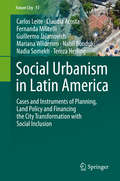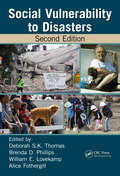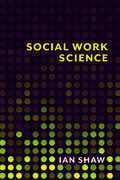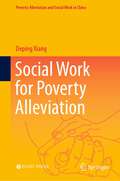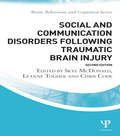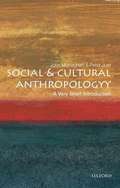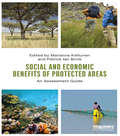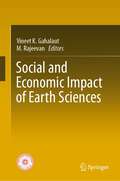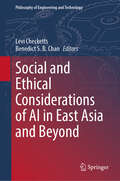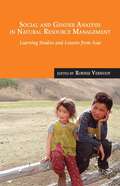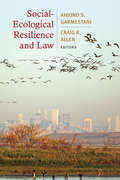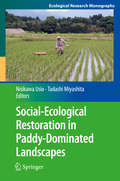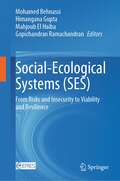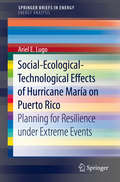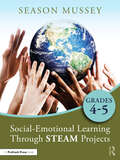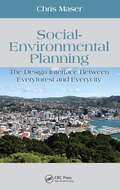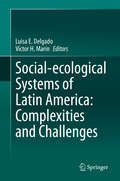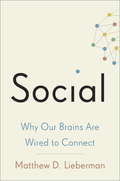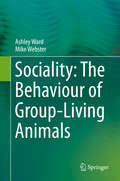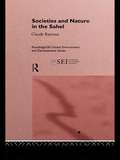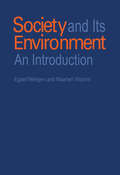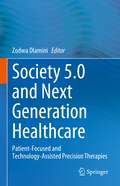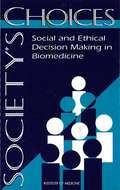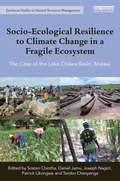- Table View
- List View
Social Urbanism in Latin America: Cases and Instruments of Planning, Land Policy and Financing the City Transformation with Social Inclusion (Future City #13)
by Carlos Leite Claudia Acosta Fernanda Militelli Guillermo Jajamovich Mariana Wilderom Nabil Bonduki Nadia Somekh Tereza HerlingThis book highlights current concepts of Social Urbanism, the contemporary set of multiple and interdisciplinary urban studies that have emerged mainly from the complex realities of Latin American cities. The discussion that follows places special emphasis on public land policy and the innovative urban instruments developed in that region to promote social and territorial inclusion. Critical reflections throughout the pages of this book shed light into the local context of each case-study in order to understand their specific set of challenges and opportunities. Relevant lessons are extracted from the three cities here analyzed, the medium-scale city of Medellin, the large-scale city of Bogota, and the megacity of Sao Paulo, as well as from local innovative experiences in Argentina and Uruguay. These cities underwent promising transformation processes over two decades, applying planning and financing instruments of land policy which have produced significant shifts in the urban development paradigm in the region. The quest for social inclusion has emerged as the common denominator in these cities, awakening growing interest across several fields of urban studies, from public policies and city management to urban law, city financing, urban development, and innovative community participation processes. The book brings implications on urban land policy for transition cities in the Global South. The question of social inclusion in Global South cities is however far from being solved; the analysis presented in this book shows advances and hope, besides a long path still ahead, which can only be faced through a continuous and challenging incremental process. May this book be an incremental step.
Social Vulnerability to Disasters
by Alice Fothergill Brenda D. Phillips Deborah S.K. Thomas William E. LovekampThe 2010 Haiti and Chili earthquakes, the 2010 BP oil spill in the Gulf of Mexico, and the 2011 Fukushima earthquake and tsunami in Japan are but a few examples of recent catastrophic events that continue to reveal how social structure and roles produce extensive human suffering and differential impacts on individuals and communities. These events
Social Work Science
by Ian ShawWhat is the role of science in social work? Ian Shaw considers social work inventions, evidence-based practice, the history of scientific claims in social work practice, technology, and social work research methodology to demonstrate the significant role that scientific language and practice play in the complex world of social work.By treating science as a social action marked by the interplay of choice, activity, and constraints, Shaw links scientific and social work knowledge through the core themes of the nature of evidence, critical learning and understanding, justice, and the skilled evaluation of the subject. He shows specifically how to connect science, research, and the practical and speaks to the novel topics this integration introduces into the discipline, including experience, expertise, faith, tacit knowledge, judgment, interests, scientific controversies, and understanding.
Social Work for Poverty Alleviation (Poverty-Alleviation and Social Work in China)
by Deping XiangThis book studies poverty issues by using social work theories and methods. It illustrates the values, theories, elements, contents, and processes of anti-poverty social work, summarizes the development of China’s anti-poverty policies, and explores the models and methods of anti-poverty social work in China. This book represents the research results of the National Social Science Foundation Project “Research on Dynamic Monitoring and Effectiveness Evaluation of the Implementation of Targeted Poverty Alleviation Strategy” (16ZDA022) and China’s Ministry of Education’s Philosophy and Social Science Development Construction (Incubation) Project Report “Anti-Poverty Development Report in China” (11JBGP038).
Social and Communication Disorders Following Traumatic Brain Injury (Brain, Behaviour and Cognition)
by Leanne Togher Chris Code Skye McDonaldTraumatic brain injury (TBI) can seriously disrupt the social and communication skills that are basic requirements for everyday life. It is the loss of these interpersonal skills that can be the most devastating for people with TBI and their families. Although there are many books that focus upon TBI, none focus on communication and communication skills specifically. This book fills this important gap in the literature and provides information ranging from a broad overview of the nature of pathology following TBI and its effects on cognition and behaviour, through to the latest evidence about ways to assess and treat social and communication disorders. Much has changed in the field of communication disorders and TBI since the first edition of this book was published in 1999. There have been advances in neuroimaging, providing more accurate understanding of how the brain is damaged in TBI and also insights into its repair. There has been a burgeoning interest in social cognition, and advances in how communication is conceptualized, with a particular focus on the role of how context facilitates or impedes communicative ability. Most importantly, much has changed in the arena of rehabilitation. There is now a growing evidence base of treatments aimed at improving communication problems following TBI, new resources for accessing this information and renewed interest in different kinds of methods for demonstrating treatment effects. Bringing together a range of expert international researchers interested in understanding the nature and treatment of TBI this book covers topics from understanding how the brain damage occurs, how it affects social and communication skills and how these problems might be treated. As such it will be of great interest to clinicians, postgraduate and undergraduate students and researchers in neuropsychology, speech and language pathology.
Social and Cultural Anthropology: A Very Short Introduction
by John Monagham Peter JustIf you want to know what anthropology is, look at what anthropologists do, write the authors of Social and Cultural Anthropology: A Very Short Introduction. This engaging overview of the field combines an accessible account of some of the discipline's guiding principles and methodology with abundant examples and illustrations of anthropologists at work. Peter Just and John Monaghan begin by discussing anthropology's most important contributions to modern thought: its investigation of culture as a distinctively human characteristic, its doctrine of cultural relativism, and its methodology of fieldwork and ethnography. Drawing on examples from their own fieldwork in Indonesia and Mesoamerica, they examine specific ways in which social and cultural anthropology have advanced our understanding of human society and culture. Including an assessment of anthropology's present position, and a look forward to its likely future, Social and Cultural Anthropology will make fascinating reading for anyone curious about this social science.
Social and Economic Benefits of Protected Areas: An Assessment Guide
by Marianne Kettunen Patrick Ten BrinkProtected areas (PAs) contain biodiversity and ecosystems of high conservation value. In addition, these areas provide a range of benefits, both direct and indirect, to our societies and economies, i.e. so called ecosystem services. These services include, for example, an ecosystem's ability to regulate floods and climate, purify water, secure the pollination of crops, and create opportunities for recreation, culture and tourism. This book offers a comprehensive introduction to the socio-economic benefits of PAs and PA networks and provides step-by-step practical guidance on identifying, assessing and valuing the various ecosystem services and related benefits provided by PAs. It also aims to improve the communication of PA benefits to different stakeholders and the general public. It is shown that identifying and valuing the socio-economic benefits of PAs can be beneficial for several reasons. Demonstrating socio-economic importance of a protected site can significantly increase political and stakeholder support for the site and resolve conflicts between different interest groups. This can lead to positive changes in policies and decision-making. Insights on PA benefits are also needed to identify a combination of actions and land use practices that best support the sustainable and equitable utilisation of these benefits, while retaining a site’s conservation goals. Finally, demonstrating different benefits can help to discover alternative and sustainable sources for financing the management of PAs.
Social and Economic Impact of Earth Sciences
by Vineet K. Gahalaut M. RajeevanThis book collects research papers on the economic and social impact of earth sciences. It covers topics related to weather forecasting, climate modelling, monsoon variability, air pollution, heat and cold wave, deep sea mineral and living resources, ocean state monitoring, tsunami and earthquake monitoring, desalination, coastal research, etc. The book focuses on the activities of the Ministry of Earth Sciences, India, in promoting the societal and economic impacts of earth science research in a simple language and in the form of stories and case studies, so that people with basic science degree can understand them.
Social and Ethical Considerations of AI in East Asia and Beyond (Philosophy of Engineering and Technology #47)
by Benedict S. B. Chan Levi CheckettsThis book is a global reflection on disparate religious and philosophical approaches to questions of AI and the particular ways these questions affect East Asian societies. These chapters originate from a conference held at Hong Kong Baptist University in April 2023 on “Ethical and Social Issues in AI: East Asia and Beyond.” Sections cover Confucianist, Daoist, and Christian reflections on AI ethics. Chapters on broad theoretical questions that AI poses are included as well as those addressing issues in applied AI ethics. This volume appeals to students and researchers working across cultures and traditions on the philosophy of AI technology.
Social and Gender Analysis in Natural Resource Development: Learning Studies and Lessons From Asia
by Ronnie VernooyThis volume presents encounters with rural men and women in South Asian and Southeast Asian countries working for local and national governments and for non-governmental organizations. Six case studies are offered to highlight the diversity of efforts to integrate social and gender analysis into natural resource management research. These cases present examples of challenges and opportunities, as well as successes and disappointments encountered while integrating social and gender analysis. They also demonstrate the variety of methods used and adapted in diverse contexts, reflect on what has been done and is being done in terms of capacity development and, most importantly, how this is being done and the factors that affect the process.
Social-Ecological Resilience and Law
by Craig Allen Ahjond GarmestaniEnvironmental law envisions ecological systems as existing in an equilibrium state, reinforcing a rigid legal framework unable to absorb rapid environmental changes and innovations in sustainability. For the past four decades, "resilience theory," which embraces uncertainty and nonlinear dynamics in complex adaptive systems, has provided a robust, invaluable foundation for sound environmental management. Reforming American law to incorporate this knowledge is the key to sustainability. This volume features top legal and resilience scholars speaking on resilience theory and its legal applications to climate change, biodiversity, national parks, and water law.
Social-Ecological Restoration in Paddy-Dominated Landscapes
by Nisikawa Usio Tadashi MiyashitaWith a focus on environmentally friendly rice farming, this unique book integrates both ecosystem and human dimensions of ecological restoration to provide strategies to promote sustainable agriculture and rural development. Paddy fields have multiple functions beyond their role of producing rice: They serve as refuge habitats for a range of wildlife that once inhabited floodplain wetlands and contain a number of unique and threatened aquatic species. They also provide various ecosystem services for regional communities such as water retention, erosion control, flood control, fish culture, and educational opportunities. However, rice paddies are threatened worldwide due to the modernization of agriculture and abandonment of farmland caused by depopulation and the aging of rural communities. Therefore, multiple ecological and sociological aspects must be considered in the ecological restoration of paddy fields. This book aims to do so by incorporating various disciplines of natural and social sciences. Strategies for sustainable agriculture are reviewed, including financial incentives for farmers and the use of flagship wildlife species such as the crested ibis (toki) to promote ecological restoration. With the increasing popularity of environmentally friendly rice farming in parts of Asia and the western United States, this book offers model cases for sustainable management of paddy-dominated landscapes.
Social-Ecological Systems (SES): From Risks and Insecurity to Viability and Resilience
by Mohamed Behnassi Gopichandran Ramachandran Himangana Gupta Mahjoub El HaibaThis book contributes to the multidisciplinary debate about social–ecological systems (SES) within the perspective of rethinking the nature of interaction between these systems, especially in the Anthropocene Era. Most chapters either deliberate on risk dynamics threatening current SES or stimulate thought processes to manage such risks and related negative implications. After analyzing the main drivers of SES vulnerability, the book highlights the shifts to be made to enhance the sustainability and resilience of these systems, mainly the integration and restructuring of governance frameworks, the reorganization of production and consumption systems far from conventional models based on consumerism, the elaboration of mitigation, adaptation, and SDGs implementation measures from a co-benefit perspective, and the consideration of appropriate approaches and paradigms while elaborating and implementing response mechanisms. This volume is relevant to researchers/experts, students, practitioners, and decision-makers from different scales and spheres.
Social-Ecological-Technological Effects of Hurricane María on Puerto Rico: Planning for Resilience under Extreme Events (SpringerBriefs in Energy)
by Ariel E. LugoThis book deals with the immediate effects of, and response to, Hurricane María on the social, ecological, and technological systems (SETS) of Puerto Rico. The SETS approach to analyzing hurricane effects places into historical context the role of social and technological factors, and compares social and ecological resilience on the same temporal scales. Written from the perspective of a Puerto Rican scientist who experienced Maria's wrath first-hand, the book uses extensive empirical knowledge of the ecological effects of hurricanes on Caribbean forests and combines that knowledge with a detailed analysis of the effects of Hurricane María on the social and technological fabric of Puerto Rico.The comparison suggests that the effects of extreme events are dictated not only by the strength of the physical event, but also by the conditions of affected SETS at the time when the event exerts influence over them. Moreover, SETS have historical legacies that influence how resilient they can be when affected by an extreme event. Therefore, preparation and response to extreme events require an integrated social, ecological, and technological effort, known as the SETS response. The SETS response requires an understanding of the energetics of extreme events and their effects on the economy, which in turn determines social and technological resilience. Hurricane María demonstrated that the social and technological systems of Puerto Rico were not adapted to dealing with extreme events, in contrast with the ecological systems, which were. Hurricane María’s effect on Puerto Rico can be used as an example from which valuable lessons emerge for making SETS more adaptable and resilient to extreme events.
Social-Emotional Learning Through STEAM Projects, Grades 4-5
by Season MusseySocial-Emotional Learning Through STEAM Projects, Grades 4–5 helps educators target the development of social and emotional learning (SEL) competencies for high-ability learners through interdisciplinary, project-based inquiry. Aligned with STEAM content standards, each of the nine projects introduces students to a real-world problem through essential questions and the presentation of a primary source document. Both the content and the inquiry process support SEL competency development, from self-awareness to selfmanagement, social awareness, relationship skills, and responsible decision-making. As students work to understand and pose solutions to each problem, they gain the knowledge and practical skills needed to become more socially and emotionally competent individuals in their classroom communities.
Social-Environmental Planning: The Design Interface Between Everyforest and Everycity (Social Environmental Sustainability)
by Chris MaserWith the environment, climate change, and global warming taking center stage in the national debate, the issues seem insurmountable and certainly unsolvable at the local level. Written by Chris Maser, international consultant on forest ecology, sustainable forestry practices, and sustainable development, Social-Environmental Planning: The Design In
Social-ecological Systems of Latin America: Complexities and Challenges
by Luisa E. Delgado Víctor H. MarínHuman societies are influencing nature in such a way that their independent analysis is no longer suitable. Fortunately, social-ecological systems provide a conceptual framework for the interconnected analysis of societies and ecosystems. However, in the case of Latin America, the complexity of social-ecological processes undermined a much-needed compilation of theoretical concepts, methods and case studies. Increasing readers’ understanding of such systems using a postnormal approach, the book discusses current concepts and methods with examples of studies from eight countries. It is a useful resource for social actors, government decision makers and scholars.
Social: Why Our Brains Are Wired to Connect
by Matthew D. LiebermanWe are profoundly social creatures - more than we know. In Social, renowned psychologist Matthew Lieberman explores groundbreaking research in social neuroscience revealing that our need to connect with other people is even more fundamental, more basic, than our need for food or shelter. Because of this, our brain uses its spare time to learn about the social world - other people and our relation to them. It is believed that we must commit 10,000 hours to master a skill. According to Lieberman, each of us has spent 10,000 hours learning to make sense of people and groups by the time we are ten. Social argues that our need to reach out to and connect with others is a primary driver behind our behavior. We believe that pain and pleasure alone guide our actions. Yet, new research using fMRI - including a great deal of original research conducted by Lieberman and his UCLA lab -- shows that our brains react to social pain and pleasure in much the same way as they do to physical pain and pleasure. Fortunately, the brain has evolved sophisticated mechanisms for securing our place in the social world. We have a unique ability to read other people's minds, to figure out their hopes, fears, and motivations, allowing us to effectively coordinate our lives with one another. And our most private sense of who we are is intimately linked to the important people and groups in our lives. This wiring often leads us to restrain our selfish impulses for the greater good. These mechanisms lead to behavior that might seem irrational, but is really just the result of our deep social wiring and necessary for our success as a species. Based on the latest cutting edge research, the findings in Social have important real-world implications. Our schools and businesses, for example, attempt to minimalize social distractions. But this is exactly the wrong thing to do to encourage engagement and learning, and literally shuts down the social brain, leaving powerful neuro-cognitive resources untapped. The insights revealed in this pioneering book suggest ways to improve learning in schools, make the workplace more productive, and improve our overall well-being. From the Hardcover edition.
Sociality: The Behaviour of Group-Living Animals
by Ashley Ward Mike WebsterThe last decade has seen a surge of interest among biologists in a range of social animal phenomena, including collective behaviour and social networks. In 'Animal Social Behaviour', authors Ashley Ward and Michael Webster integrate the most up-to-date empirical and theoretical research to provide a new synthesis of the field, which is aimed at fellow researchers and postgraduate students on the topic.
Societies and Nature in the Sahel (Routledge/SEI Global Environment and Development Series #Vol. 1)
by Philippe Lavigne Delville Emmanuel Gregoire Pierre Janin Jean Koechlin Claude RaynautThis book explores the links between environment and social systems in the Sahel, integrating ecological, demographic, economic, technical, social and cultural factors. Examining the conditions for land occupation and natural resource use, it offers a conceptual and practical approach to social organization and environmental management.
Societies of Brains: A Study in the Neuroscience of Love and Hate (INNS Series of Texts, Monographs, and Proceedings Series)
by Walter J. FreemanThis monograph from a leading neuroscientist and neural networks researcher investigates and offers a fresh approach to the perplexing scientific and philosophical problems of minds and brains. It explains how brains have evolved from our earliest vertebrate ancestors. It details how brains provide the basis for successful comprehension of the environment, for the formulation of actions and prediction of their consequences, and for cooperating or competing with other beings that have brains. The book also offers observations regarding such issues as: * how and why people fall in and out of love; * the biological basis for experiencing feelings of love and hate; and * how music and dance have provided the ancestral technology for forming social groups such as tribes and clans. The author reviews the history of the mind-brain problem, and demonstrates how the new sciences of behavioral electrophysiology and nonlinear dynamics -- combined with the latest computer technology -- have made it possible for us to observe brains in action. He also provides an answer to the question: What happens to a stimulus after it enters the brain? The answer: The stimulus triggers the construction of a percept and is then washed away. All that we know is what our brains construct for us by neurodynamics. Brains are not logical devices that process information. They are dynamical systems that create meaning through interactions with the environment -- and each other. The book shows how the learning process by which brains construct meaning tends to isolate brains into self-centered worlds, and how nature has provided a remedy -- first appearing in mammals as a mechanism for pair-bonding -- to ensure reproduction of the young dependent on parents. The remedy is based in the neurochemistry of sex which serves to dissolve belief structures in order to open the way for new patterns of understanding and behavior. Individuals experience these changes in various ways, such as falling in love, collegiate indoctrination, tribal bonding, brain washing, political or religious conversions, and related types of socialization. The highest forms of meaning for humans come through these social attachments.
Society & Its Environment: An Introduction
by TellegenFirst Published in 1998. Routledge is an imprint of Taylor & Francis, an informa company.
Society 5.0 and Next Generation Healthcare: Patient-Focused and Technology-Assisted Precision Therapies
by Zodwa DlaminiThis book analyses the ability of technological advancements to represent, enhance, and empower multidisciplinarity in the context of Society 5.0. and next generation medicine. New technologies allow patients to communicate with medical personnel anytime, anywhere and shape the terrain of healthcare ecosystem at an unprecedented rate. Five main trends become apparent in this process: Hybrid care models combining virtual and in-person services, digitization of healthcare specialties, increased Artificial intelligence (AI) adoption, health systems moving to the cloud and advanced precision medicine.In its chapters the book dissects the important roles for technologies in areas such as digital twinning, big data, Internet of Things, AI, cyber-physical systems, blockchain technology to lead the healthcare digitalization envisioned in Society 5.0. Throughout the book the authors discuss how to incorporate these new technologies legally, ethically, safely, and securely and in keeping with the highest standards of human rights. It also advocates for the need for careful oversight and mindful allocation of resources and energy for sustainable development.This book, written by experts in the field from academia and industry, will appeal to researchers, healthcare professionals, policy makers, teachers and students interested in the ways healthcare is reorganized based on digital transformation efforts and the rethinking of care, including technologies.
Society's Choices: Social and Ethical Decision Making in Biomedicine
by Harvey V. Feinberg Ruth E. Bulger Elizabeth M. BobbyBreakthroughs in biomedicine often lead to new life-giving treatments but may also raise troubling, even life-and-death, quandaries.Society's Choices discusses ways for people to handle today's bioethics issues in the context of America's unique history and culture--and from the perspectives of various interest groups.The book explores how Americans have grappled with specific aspects of bioethics through commission deliberations, programs by organizations, and other mechanisms and identifies criteria for evaluating the outcomes of these efforts. The committee offers recommendations on the role of government and professional societies, the function of commissions and institutional review boards, and bioethics in health professional education and research.The volume includes a series of 12 superb background papers on public moral discourse, mechanisms for handling social and ethical dilemmas, and other specific areas of controversy by well-known experts Ronald Bayer, Martin Benjamin, Dan W. Brock, Baruch A. Brody, H. Alta Charo, Lawrence Gostin, Bradford H. Gray, Kathi E. Hanna, Elizabeth Heitman, Thomas Nagel, Steven Shapin, and Charles M. Swezey.
Socio-Ecological Resilience to Climate Change in a Fragile Ecosystem: The Case of the Lake Chilwa Basin, Malawi (Earthscan Studies in Natural Resource Management)
by Sosten Chiotha Daniel Jamu Joseph Nagoli Patrick Likongwe Tembo ChanyengaThe Lake Chilwa Basin Climate Change Adaptation Programme was a seven-year research and development programme in Malawi that concluded in March 2017. The programme was designed to protect the livelihoods of the population and enhance resilience of the natural resource base upon which it depends. The Lake Chilwa Basin is an important wetland ecosystem which is a designated Ramsar Site under the Ramsar Wetland Convention and a Man and Biosphere Reserve designated by UNESCO. This book provides a review of the research and programme interventions done based on the ecosystem approach (EA), a strategy for the integrated management of land, water and living resources. This is designed to promote biodiversity conservation and sustainable use in an equitable way in its implementation of mitigation and climate change adaptation interventions. It is shown how: local and district institutions were strengthened to better manage natural resources and build resilience to climate change; cross-basin and cross-sector natural resource management and planning for climate change throughout the Basin were built; household and enterprise adaptive capacity in Basin hotspots was built; and improved forest management and governance contributed in mitigating the effects of climate change. The study followed all the twelve key EA principles with involvement of all key stakeholders. It is one of the first programmes to apply EA on such a wide temporal and spatial scale and provides key lessons to be learned for the protection of other fragile ecosystems in an era of climate change.
